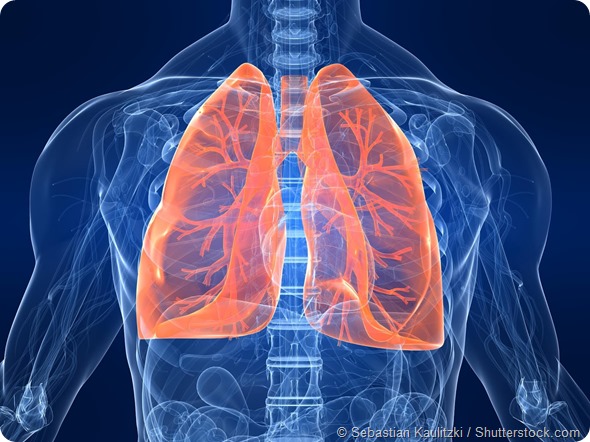What are the main benefits of delivering drugs directly to the lungs via inhaled drug delivery?
Delivering drugs to the lungs via inhalation has a number of potential advantages over traditional routes of administration like pills or injections. For treating pulmonary diseases, the obvious logic we are applying is topical delivery to the airways via inhalation.
iSPERSE Platform for Pulmonary Diseases by Pulmatrix, Inc.
By understanding where the drug deposits in the airway, we can target treatment to a specific area in the lung and treat a lung disease at the site of disease.
This also allows us the chance to significantly reduce the amount of drug delivered to the patient as opposed to oral delivery where you have to give high doses to get enough of the drug from the GI tract via the bloodstream into the lung tissue. Delivery directly to the lung also avoids first pass metabolism which can be very important for the efficacy of the drug.
Another advantageous aspect of the lung is for systemic drug delivery. The human lung has a very large alveolar surface area that can allow ready access to the bloodstream. Inhaling microscopic sized drug formulations delivers medications to the alveoli where the drugs can readily enter the bloodstream.
An inhaled formulation at the appropriate dose can deliver an intravenous-like pharmacokinetic profile with matching peak concentrations, time to peak levels, and similar exposure over time.
Please can you give a brief history of inhaled drug delivery techniques?
Inhalation to deliver medications into the airway has been known since antiquity. Nebulizers have long been used to deliver liquid aerosols to patient airways. The invention of the metered dose inhaler (MDI) in the 1940s really inspired the idea of pocket-sized portable inhalation devices. These are the typical “asthma puffers” we are all familiar with that produce an aerosol of tiny droplets that can be inhaled.

Dry powder inhalers based on lactose carriers (DPI-LB) came along next. With this dry powder technology, micronized drug is adsorbed to the surface of a large lactose carrier. When the patient inhales, theoretically, the drug comes off the lactose surface and is small enough aerodynamically to travel into the patient airway while the lactose lands in the back of the throat and is swallowed.
These MDI and DPI-LB technologies have been the basis of a number of very successful products for patients. However, these technologies are limited by the types of drugs that can be used, doses that can be delivered, and suboptimal delivery efficiency.
This led engineers in the late ‘90s to think about different ways to make better dry powders with improved delivery characteristics. Large, porous particles like the AIR technology and Nektar Pulmospheres allowed scientists to think about a much wider range of drugs for pulmonary delivery.
These powders deliver drugs more efficiently and because of the way they are made, higher doses can be delivered in each inhalation. These formulations can deliver three times as much drug or even higher compared to DPI-LB. This opened up the universe for pulmonary drug delivery.
At Pulmatrix, we’re bringing forward the next generation engineered approach. Our iSPERSE technology is an engineered dry powder with a higher density profile than the previous technologies but with all the same delivery advantages.
Combining this with our expertise around nano-sized drug particles that can be combined in our iSPERSE formulations, we can consider virtually any medication for pulmonary drug delivery.
Which conditions could particularly benefit from inhaled drug delivery?
There are a wide array of pulmonary diseases that can benefit from inhaled drug delivery. COPD and asthma have been served by inhaled drugs for decades and are very large patient populations that still have significant unmet needs.
The rare disease cystic fibrosis uses a number of inhaled drugs with a number in development. Other rare lung diseases like idiopathic pulmonary fibrosis are currently treated with oral formulations and inhalation seems like an obvious direction to go.
Scientists have considered local treatment of lung cancer by inhalation. Essentially the entire list of pulmonary diseases could be considered.
And if we consider systemic conditions that could benefit from rapid exposure of drug to the bloodstream, the list encompasses every major disease area: metabolic, reproductive, pain, neuropsychiatry, cardiovascular.

What are the limitations to delivering drugs to the lungs with nebulizers?
Nebulizers have long been used by hospitalized patients and patients in the home setting. But they are not ideal for patients which is why all the other technologies have come along.
Nebulizers have typically low efficiency. What this translates to for patients are longer dosing times where they have to wear a mask or breathing on a mouthpiece for long periods of time, typically several to tens of minutes depending on the dose.
The amount of drug wasted over these dosing periods is quite high which can matter for side effects and cost of goods. Another challenge is the single dose nature of nebulizers which require regular cleaning unlike the other technologies.
Could you please give an overview of Pulmatrix’s patented particle engineering technology iSPERSE?
iSPERSE is an engineered dry powder particle technology made by spray-drying which allows us to consider formulating virtually any drug class in an easily inhaled form. The hallmark of the technology is small, dense, and dispersible which drives the patent novelty and differentiates the technology from other engineered particle technologies (ex Nektar Pulmospheres).
Key highlights of iSPERSE are 1) high delivery efficiency deliver 3X or more drug per inhalation than traditional technologies; 2) flow rate independence which means patients with compromised lung function can still easily and reproducibly receive their dose; 3) higher dose ranges enabling inhalation treatment with drugs that require higher doses; and 4) the ability to formulate virtually any drug class from small molecules and combinations through biologics including nucleic acids, peptides, proteins, and even antibodies.
And because of the differentiating higher density profile of iSPERSE from other engineered low density powders, the technology can work with any dry powder inhaler device, capsule-, reservoir-, or blister-based.
What limitations does iSPERSE solve?
We look at iSPERSE as improving approaches of today while enabling new approaches for tomorrow. Because of the high delivery efficiencies of iSPERSE, we can make better versions of currently inhaled drugs based on nebulizers, MDI, or DPI-LB.
In terms of new approaches, iSPERSE allows us to consider inhalation of molecules that have typically not been considered or required lengthy nebulizations. MDI/DPI technologies can only deliver microgram to low mg quantities of drug per inhalation which limits them to potent molecules.
In contrast, iSPERSE can deliver tens of milligrams per inhalation. This opens up the entire range of drug classes that iSPERSE could deliver by inhalation. Our current pipeline employs this capability for our inhaled antifungal and for our undisclosed idiopathic pulmonary fibrosis projects.
What impact do you think inhaled drug delivery could have on antimicrobial resistance?
In the case of our inhaled antifungal, the local delivery of an overwhelming dose of the antifungal agent, over whelming in terms of eradicating fungus, should reduce concerns about resistance development.
Concerns of resistance are typically associated with threshold therapeutic doses which can allow a bug to “escape” antimicrobial activity. These escape bugs can then become resistant. By delivering a dose higher than the threshold, we should reduce this concern.
What do you think the future holds for inhaled drug delivery and what’s Pulmatrix’s vision?
We think inhaled drug delivery will continue to grow as an approach for treating diseases  both local and systemic. We’ve learned from market research that many patients like the ease of use, portability, and route of delivery to avoid the GI effects many drugs have. We look forward to being at the forefront of engineering these approaches starting with our current pipeline.
both local and systemic. We’ve learned from market research that many patients like the ease of use, portability, and route of delivery to avoid the GI effects many drugs have. We look forward to being at the forefront of engineering these approaches starting with our current pipeline.
Where can readers find more information?
Our website is www.pulmatrix.com
About Dr Robert Clarke
Dr. Clarke was promoted to Chief Executive Officer of Pulmatrix in 2012 after serving as the Chief Scientific Officer. Joining Pulmatrix in 2004 as the first Ph.D. level scientist, his role evolved to oversight of Research and Development efforts at Pulmatrix focused on developing the Pulmatrix technologies for treatment of respiratory disease.
He has helped raise greater than $60 million in venture capital funding for the company as well as secured more than $10 million in non-dilutive funding to support Pulmatrix R&D programs. Previous to Pulmatrix, he was an Associate Director of Life Sciences at Alkermes, Inc. focused mainly on developing inhaled therapeutic products with the AIR® technology platform.
Dr. Clarke holds a B.Sc. in Biomedical Engineering from Boston University, has his Ph.D. in Physiology from Johns Hopkins University, and completed his post-doctoral training in Respiratory Biology at Brigham and Women’s Hospital and Harvard University. Dr. Clarke has over a dozen years industry and over 20 years total experience focused on pulmonary drug delivery and the role of inhaled particles in respiratory biology and medicine leading to co-authorship of over 80 chapters, papers, and abstracts.